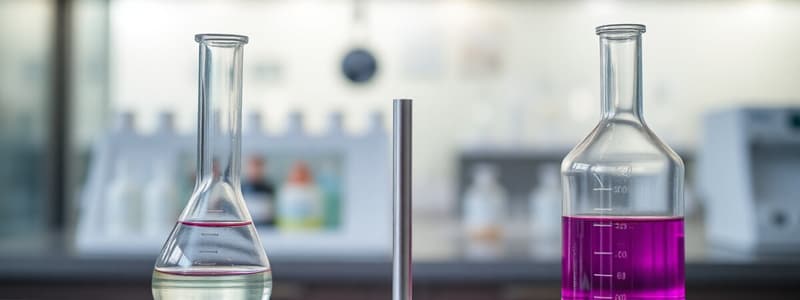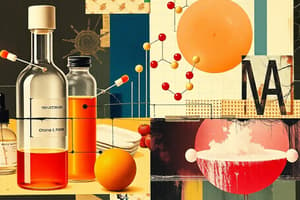Podcast
Questions and Answers
What best defines a 'system' in the context of thermodynamics?
What best defines a 'system' in the context of thermodynamics?
Which of the following is an example of an equilibrium process in pharmaceuticals?
Which of the following is an example of an equilibrium process in pharmaceuticals?
What term describes a homogeneous section of material within a dosage formulation?
What term describes a homogeneous section of material within a dosage formulation?
In pharmaceutical analysis, what does partitioning between phases typically rely on?
In pharmaceutical analysis, what does partitioning between phases typically rely on?
Signup and view all the answers
How is the concept of 'surroundings' defined in thermodynamic studies?
How is the concept of 'surroundings' defined in thermodynamic studies?
Signup and view all the answers
What kind of measurement does thermal analysis involve in the pharmaceutical context?
What kind of measurement does thermal analysis involve in the pharmaceutical context?
Signup and view all the answers
Which of the following statements about components in a pharmaceutical system is accurate?
Which of the following statements about components in a pharmaceutical system is accurate?
Signup and view all the answers
What is the primary focus of thermodynamics in relation to dosage formulations?
What is the primary focus of thermodynamics in relation to dosage formulations?
Signup and view all the answers
What is the primary purpose of the activity coefficient γi in the equation for chemical potential?
What is the primary purpose of the activity coefficient γi in the equation for chemical potential?
Signup and view all the answers
Which factor is NOT considered in the calculation of Ionic Strength I for a solution?
Which factor is NOT considered in the calculation of Ionic Strength I for a solution?
Signup and view all the answers
In the Debye Huckel Limiting Law, what does the term 'I' represent?
In the Debye Huckel Limiting Law, what does the term 'I' represent?
Signup and view all the answers
How is the mean activity a± of a salt in solution calculated?
How is the mean activity a± of a salt in solution calculated?
Signup and view all the answers
What does the symbol '±' in the activity coefficient γ± signify?
What does the symbol '±' in the activity coefficient γ± signify?
Signup and view all the answers
What does the reduced phase rule formula 'F = C - P + 1' signify in phase diagrams?
What does the reduced phase rule formula 'F = C - P + 1' signify in phase diagrams?
Signup and view all the answers
In a simple eutectic system, which region corresponds to completely solid components?
In a simple eutectic system, which region corresponds to completely solid components?
Signup and view all the answers
The eutectic point in a phase diagram can be described as:
The eutectic point in a phase diagram can be described as:
Signup and view all the answers
In the phase diagram of a simple eutectic system, what does the y-axis typically represent?
In the phase diagram of a simple eutectic system, what does the y-axis typically represent?
Signup and view all the answers
What describes the two regions of solid suspended in solution in the phase diagram?
What describes the two regions of solid suspended in solution in the phase diagram?
Signup and view all the answers
What is a defining feature of naphthalene/benzene as a simple eutectic system?
What is a defining feature of naphthalene/benzene as a simple eutectic system?
Signup and view all the answers
Which statement best describes the phase behavior in the all liquid region of a phase diagram?
Which statement best describes the phase behavior in the all liquid region of a phase diagram?
Signup and view all the answers
What characteristic distinguishes a simple eutectic system from other phase systems?
What characteristic distinguishes a simple eutectic system from other phase systems?
Signup and view all the answers
At the eutectic point, which of the following statements is true?
At the eutectic point, which of the following statements is true?
Signup and view all the answers
What defines the activity coefficient (γ) in a solution?
What defines the activity coefficient (γ) in a solution?
Signup and view all the answers
Which equation represents the relationship between free energy and equilibrium constant?
Which equation represents the relationship between free energy and equilibrium constant?
Signup and view all the answers
In the context of acids and bases, which definition aligns with the Brønsted theory?
In the context of acids and bases, which definition aligns with the Brønsted theory?
Signup and view all the answers
How does one determine the acidity of aqueous solutions?
How does one determine the acidity of aqueous solutions?
Signup and view all the answers
What is the significance of pKa in relation to acid strength?
What is the significance of pKa in relation to acid strength?
Signup and view all the answers
What describes conjugate bases in acid-base reactions?
What describes conjugate bases in acid-base reactions?
Signup and view all the answers
In dilute solutions, how can activities be approximated?
In dilute solutions, how can activities be approximated?
Signup and view all the answers
Which condition is true regarding a strong acid in terms of its Ka and pKa values?
Which condition is true regarding a strong acid in terms of its Ka and pKa values?
Signup and view all the answers
For a monoprotic acid (AH) dissociating in water, which formula correctly describes the dissociation?
For a monoprotic acid (AH) dissociating in water, which formula correctly describes the dissociation?
Signup and view all the answers
What defines polyprotic acids like H3PO4?
What defines polyprotic acids like H3PO4?
Signup and view all the answers
What occurs when the free energy change ($\Delta G$) is equal to zero?
What occurs when the free energy change ($\Delta G$) is equal to zero?
Signup and view all the answers
How is the relationship between $\Delta G$ and the equilibrium constant $K_{eq}$ expressed?
How is the relationship between $\Delta G$ and the equilibrium constant $K_{eq}$ expressed?
Signup and view all the answers
If the value of $\Delta G$ is less than zero ($\Delta G < 0$), what does this indicate about the reaction?
If the value of $\Delta G$ is less than zero ($\Delta G < 0$), what does this indicate about the reaction?
Signup and view all the answers
At what point is the change in free energy ($\Delta G°$) relevant?
At what point is the change in free energy ($\Delta G°$) relevant?
Signup and view all the answers
What is the equilibrium concentration of fructose-6-phosphate ($\text{[F6P]}$) if the reaction starts with 0.1 M of glucose-6-phosphate ($\text{[G6P]}$) and $\Delta G°$ for the process is 2.1 kJ mol−1?
What is the equilibrium concentration of fructose-6-phosphate ($\text{[F6P]}$) if the reaction starts with 0.1 M of glucose-6-phosphate ($\text{[G6P]}$) and $\Delta G°$ for the process is 2.1 kJ mol−1?
Signup and view all the answers
What does the equation $\Delta G - \Delta G° = RT \ln K_{eq}$ represent?
What does the equation $\Delta G - \Delta G° = RT \ln K_{eq}$ represent?
Signup and view all the answers
If the concentration of G3P decreased from 0.05 M to 0.002 M after reaching equilibrium, what can be inferred about the reaction's spontaneity?
If the concentration of G3P decreased from 0.05 M to 0.002 M after reaching equilibrium, what can be inferred about the reaction's spontaneity?
Signup and view all the answers
What key concept relates stability and the condition of a system in equilibrium?
What key concept relates stability and the condition of a system in equilibrium?
Signup and view all the answers
What is the change in free energy ($\Delta G°$) typically associated with spontaneous reactions?
What is the change in free energy ($\Delta G°$) typically associated with spontaneous reactions?
Signup and view all the answers
What happens to the system if it is not at equilibrium?
What happens to the system if it is not at equilibrium?
Signup and view all the answers
Study Notes
Thermodynamics and Pharmaceuticals
- Dosage formulations are governed by thermodynamics and process equilibria.
- Equilibrium processes include:
- Drug binding to receptors or enzymes.
- Biochemical reactions in metabolism.
- Manufacturing Active Pharmaceutical Ingredients (APIs).
- Formulation processes.
- Equilibrium constants are often used to measure pharmacological activity.
System and Surroundings
- A system is a defined part of the physical world under study.
- Surroundings are the rest of the physical world that is affected by changes in the system.
Equilibrium and Energy
- Equilibrium is defined by equilibrium constants (Keq).
-
Energy is defined by:
- First Law: H (enthalpy change)
- Second Law: S (entropy change)
- Gibbs Free Energy: G = H – TS
- Equilibrium occurs when G = 0.
- Spontaneous change occurs when G < 0.
The Relationship between Gibbs Free Energy and Equilibrium Constant
- At equilibrium, G° = −RTlnKeq.
- If not at equilibrium, G − G° = RTlnKeq
- G is the system's free energy; G° is the free energy at equilibrium.
Phases in Pharmaceuticals
- Pharmaceuticals can exist in multiple phases (states of matter, e.g., liquid, solid).
- The reduced phase rule for fixed pressure is: F = C − P + 1, where:
- F = degrees of freedom
- C = number of components
- P = number of phases
Simple Eutectic System
- A simple eutectic system has two components (A and B) and four regions:
- All liquid at higher temperatures.
- All solid at lower temperatures.
- Two regions of solid suspended in solution, one with solid A and the other with solid B.
- One point at which liquid and both solids are in equilibrium: the eutectic point.
Activity and Activity Coefficient
- Activity (ai) is a measure of the effective concentration of a component in a system.
- The activity coefficient (i) quantifies deviations from ideal behavior.
- ai = i[i] , where [i] is the concentration.
Free Energy Changes in Real Systems
- For a process, the free energy change is: ∆𝐺 = ∆𝐺 ° + 𝑅𝑇 ln 𝐾, where:
- ∆𝐺 ° = free energy under standard conditions.
- 𝐾 = equilibrium constant.
- The equilibrium constant is: 𝐾 = 𝑎𝐶𝑐 𝑎𝐷𝑑/𝑎𝐴 𝑎𝐵, where a are activities.
Pharmaceutical Solutions
- Acids and bases are important components of pharmaceutical solutions.
- Ions in solution play a significant role in pharmaceutical behavior.
Acids and Bases
- Brønsted acid: A proton (H+) donor (HA → H+ + A−).
- Brønsted base: A proton (H+) acceptor (B + H+ → BH+).
- Lewis acid: An electron-pair acceptor.
- Lewis base: An electron-pair donor.
Protons in Water
- Protons are solvated in water and represented by the hydronium ion (H3O+).
- HCl + H2O → H3O+ + Cl−.
Conjugate Acids and Bases
- Conjugate base: A− (formed when an acid donates a proton).
- Conjugate acid: BH+ (formed when a base accepts a proton).
- Acids and bases can be neutral, cationic, or anionic.
General Equilibrium for Proton Transfer
- For a transfer of a proton from an acid to a base in water:
- Equilibrium constant (K): 𝑎 𝐻3𝑂 + 𝑎 𝐵𝑎𝑠𝑒 / 𝑎 𝐴𝑐𝑖𝑑 𝑎 𝐻2𝑂
Activity and Concentration in Solutions
- Equilibrium constants (K) are determined by activities (a).
- In dilute solutions, activities can be approximated by concentrations.
Acidity of Aqueous Solutions
- Acidity is determined by [H3O+].
- pH = −log10 [H3O+].
Acid Dissociation in Water
- Acid dissociation constant (Ka): Ka = [H3O+][A-]/[HA].
- pKa = −log10Ka.
pKa
- pKa is a measure of acid strength.
- Strong acids have high Ka, low pKa.
- Weak acids have low Ka, high pKa.
Polyprotic Acids
- Polyprotic acids can donate more than one proton.
Activity of Ions in Solution
- 𝜇𝑖 = 𝜇𝑖° + 𝑅𝑇 ln 𝑎𝑖
-
Debye Huckel Limiting Law: log10 𝛾± = −𝐴𝑧+ 𝑧− 𝐼
- A is a constant.
- z+ and z- are the charges of the ions.
- I is the Ionic Strength.
Ionic Strength (I)
- The ionic strength quantifies the ionic field in a solution.
- I = ½ ∑ 𝑖 𝑧𝑖2
- It depends on the number of cations and anions in the solution.
Mean Activity of Ions
- Mean activity coefficient (γ±): a measure of the average activity coefficient of all the ions in a solution.
- Mean ionic concentration ([±]): the average concentration of the ions in a solution.
- Mean activity (a±): the average activity of the ions in a solution.
Tutorial
- The problem asks to calculate the ionic strength (I), mean activity coefficient (γ±), mean ionic concentration ([±]), and mean activity (a±) for a 0.05 M solution of MgCl2.
- MgCl2 fully dissociates into Mg2+ and 2Cl-.
- Use the Debye Huckel Limiting Law and the formulas for I, [±] and a± to calculate the values.
Studying That Suits You
Use AI to generate personalized quizzes and flashcards to suit your learning preferences.
Related Documents
Description
Explore the role of thermodynamics in pharmaceuticals, specifically in dosage formulations and equilibrium processes. This quiz examines key concepts such as energy, Gibbs Free Energy, and the relationship between equilibrium constants and pharmacological activity. Test your understanding of how thermodynamics impacts drug design and manufacturing.




